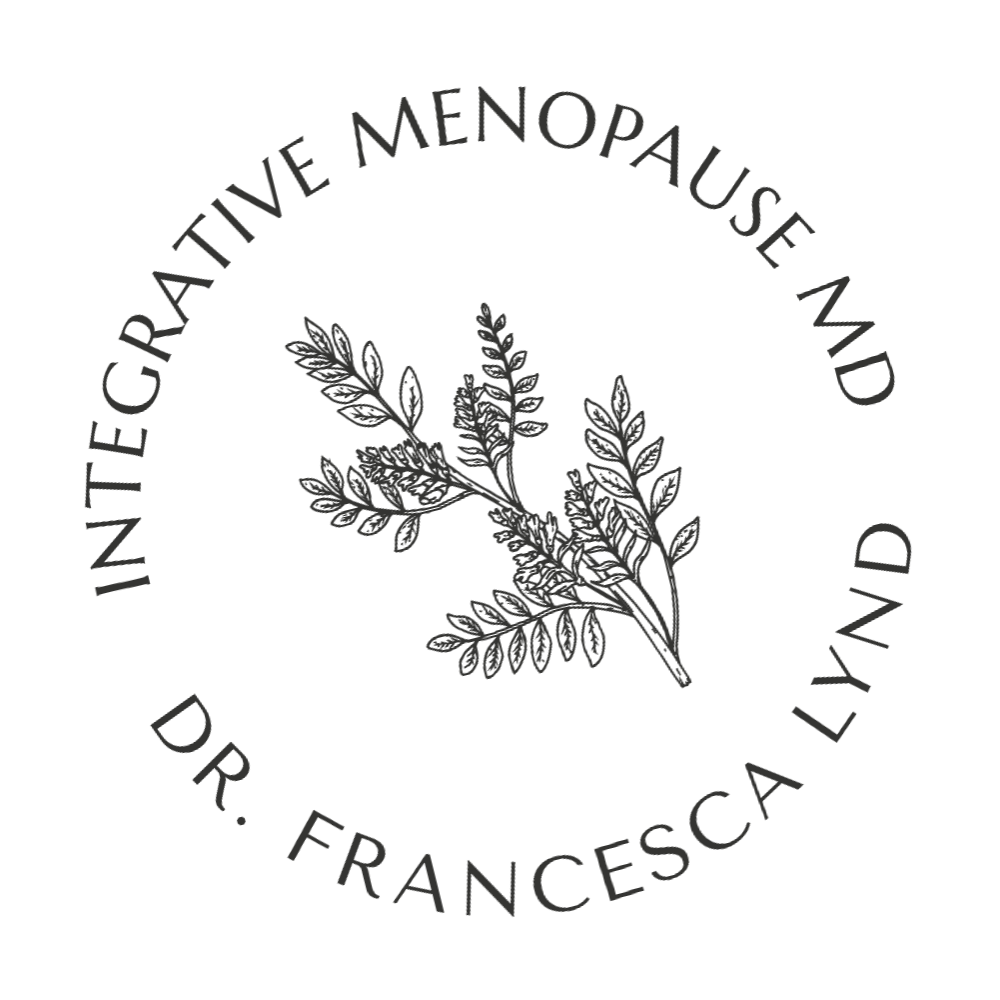Progesterone: The Unsung Heroine of Menopause!
Sep 13, 2023
Progesterone is an incredibly under appreciated hormone and a potentially underutilized tool for managing the menopause transition. Since the mid 1920’s when estrogen was “discovered,” estrogen has been touted as the female hormone. From an estrogen centric vantage point, all symptoms that women experience must be from “estrogen deficiency.” Perimenopause and and menopause came to be seen as a single downhill progression, with waning hormones leading to loss of attractiveness, vitality and health. The cultural and pharma benefit of this perspective is, well, in my opinion rather obvious. But there is a problem with this narrative. The actual lived experience of the perimenopausal woman does not fit this context.
It is during perimenopause, the years leading up to and surrounding the final period, that progesterone plays a huge role in that actual lived experience. It is during this time that the majority of women experience varying intensities of symptoms: erratic moods, irritability, reduced coping and poor sleep. Some women experience breast pain, heavier and more irregular menstrual cycles and the dreaded hot flashes. Most women also notice their menstrual cycles coming closer together in the early phase of perimenopause.
Think of the premenopausal years as leading into perimenopause which leads into menopause. Menopause and postmenopause are used interchangeably as both are defined as the time of life beyond the year after the final menstrual period.
Progesterone is the key to understanding (and possibly managing) the symptoms of perimenopause. Think of perimenopause as having an early and a late phase. Early perimenopause is often the most confusing for women. Cycles are still pretty regular but may be closer together, heavier, with longer flow and more cramping. Breasts may be tender or more lumpy, sleep is disrupted, night sweats occur, headaches are more frequent, mood is erratic, more irritable and weight gain is noted without any changes in lifestyle. I bet many of you can relate!
It is in late perimenopause when periods become less frequent, breasts are less tender, flow lightens and mood symptoms improve. But this is also when hot flashes and sleep disruption frequently worsen. Late perimenopause ends a year after the last period when we are “officially” in menopause. Unfortunately, symptoms tend to persist a few more years!
Common thinking is that all of our symptoms are from dropping estrogen. But what is less commonly acknowledged is that there are multiple physiological hormonal signals from the ovaries to brain (and brain to ovaries) that are anything but a smooth back and forth. This communication is carefully and beautifully orchestrated, in order to end the potential for menstruation and pregnancy as women become menopausal. Though carefully orchestrated, it is certainly not a straightforward nor predictable.
Average estradiol levels fluctuate higher than normal in the early perimenopause time period. Add to this, insufficient or absent ovulation is simultaneously causing much lower progesterone levels. This leads to an “estrogen dominance” picture with some women describing that they even feel pregnant!
The paradox of higher estrogen levels with declining ovarian function makes this time confusing and challenging to manage. You are not crazy! We now have a general idea of what is occurring. A new exaggerated imbalance between your estrogen and progesterone is the actual root cause for the experience of so many women during the perimenopausal transition. As women proceed through the late perimenopausal transition, estradiol gradually declines and the discrepancy between estrogen and progesterone balance slowly evens out.
The management of perimenopause is NOT one size fits all. Adding estrogen in the early perimenopause can make symptoms worse! This is a time when testing hormones may useful for some women. The traditional “menopause level” -a check of FSH (follicle stimulating hormone) has not been found to be useful nor cost effective so it is not regularly tested by itself in early perimenopause. FSH hormone signaling can remain fairly normal while estrogen fluctuates wildly. Testing progesterone is even more confusing but again, can be useful in some women. Especially if considering progesterone supplementation.
For a subset of women, knowing hormone levels during a symptomatic perimenopause transition can be highly beneficial. Understanding your hormone balance and at times even metabolites, can give you a better idea of whether you may respond to progesterone vs estradiol vs herbs vs nutrition vs repleting nutrient deficiencies with supplements. Often a combination approach is used. You have options.
Treatment may then be designed for specific needs. Sometimes a pharmaceutical “sledge hammer” is needed (think synthetic pharma) and sometimes just a gentle “nudge”(think herbal) is needed to get you back on track. Sometime the nudge has to progress to a sledge hammer and sometimes you can back off the sledge hammer rather quickly with the appropriate integrative support. The management will almost always include behavioral changes and an understanding that your physiology is changing.
Once menopausal, the calculus changes yet again. Estrogen and progesterone are more balanced again, albeit at a much lower level. At that point, progesterone therapy is used to “protect the endometrium” for women on estrogen therapy. Estrogen may stimulate the uterine lining (the endometrium) to grow (proliferate). This increases the risk of cancer in the uterus. Progesterone is highly effective in preventing uterine cancer from developing in this setting.
When considering progesterone replacement, know your options and a little history…
Progesterone comes in 2 flavors: Bioidentical and Synthetic
Progesterone got its name in the 1930’s after scientists figured out its important role in supporting pregnancy. Pro - Gestation = “Pro” “gest”- erone. By the 1940’s, scientists were able to synthesize progesterone from diosgenin, found in plants. But they found that extremely high doses were needed to see any effect since the body did such a poor job of absorbing it in the natural form. By the 1980’s, scientists figured out how to use “micronization techniques” on this natural progesterone to improve progesterone absorption. Micronized progesterone was then made available to women in the mid 1990’s. Micronized progesterone is the bioidentical progesterone that is prescribed today. The pharmaceutical prescription option is in oral form.
Now compare this to synthetic (artificial) progestins. These are synthetic compounds that bind to and have an effect on progesterone receptors. These are the progestins used in birth control (pills, injections and some IUDs) as well as many hormone replacement therapies (HRT). Most commonly, you will see medroxyprogesterone acetate (MPA) or norethindrone acetate in the HRT products.
This is where a discussion of breast cancer risk fits in.
Medroxyprogesterone acetate or “MPA” was the the progestin component most commonly used by women on hormone replacement therapy at the time the Women’s Health Initiative study was undertaken. This was the infamous study that was interpreted at the time (back in 2002) that hormones cause breast cancer. MPA was the progestin associated with a small absolute risk in breast cancer diagnosis. Keep in mind, the women in this study had an average age of starting hormone therapy of 62 and they were not “healthy” women either. In younger perimenopausal women, MPA did not seem to have the same negative effect. The WHI study was actually designed to look at the effect of hormone therapy on chronic disease prevention. Chronic diseases increase with age. So older women were selected for this study. The older the women were, the more risk for developing a chronic disease, so then you could see an impact of HRT in a shorter period of time. The less time a study takes, the lower the cost of running the study. So here lies problem. The study was not designed to look at women who were using HRT for their symptoms in the midst of the transition. The women in the study were mostly well beyond the age of symptomatic menopause. You can thank the media for the less than accurate reporting.
No one disagrees that hormone therapy is the single most effective management tool for the symptoms of the menopause transition.
We also agree that HRT should start within the first 10 years of menopause (ie 10 years from around the last period).
We also no longer use synthetic hormones (or at least we shouldn’t if it can be avoided).
The debate revolves around whether symptom relief comes at the cost of increased risk of certain chronic diseases like breast cancer, cardiovascular disease or dementia.
We have 20 years of data now that suggest that the timing of hormone therapy onset as well as your health status when starting therapy both matter quite a bit. Both can impact the risk of chronic disease and potential future health benefits. Every woman deserves a discussion about her individual risk!
Another frustrating fall out from the reporting on the WHI study is that even though the products used in the study are no longer used today, we will likely not see funding to get a good study on current bioidentical hormones to compare to these results. Again, time and money are needed.
The good news is that looking at the results of this single unfortunate study and all the excellent studies since, does allow us the confidence to be very comfortable recommending hormone therapy to most women at the time of the menopause transition in order to treat symptoms. You don't need to suffer.
Now let us get back to when and why to use progesterone…
For hormone replacement therapy, the conventional thinking is that the progesterone component is only needed for preventing endometrial (uterine) cancer in women taking estrogen to control menopausal symptoms. This is why progesterone is rarely offered to women who have had a hysterectomy.
But don’t forget early perimenopause…
That wonderful time when estradiol soars erratically while progesterone is slowly decreasing—Ugh!. Progesterone is an amazing hormone that deserves much more consideration. Micronized oral progesterone does appear safe for perimenopausal women. It may decrease the risk of cancer of the uterine endometrium and does not show increased risk for blood clots. In addition, micronized progesterone may help women burn more calories per day so may actually help with preventing weight gain, may decrease anxiety, and all while also helping with sleep.
Depending on where you are in your perimenopause journey, you may either want to cycle your progesterone or take it continuously. Either way, you would want to take it at night to help with sleep. If periods are fairly regular, you would take oral progesterone for 12-14 days in the luteal phase (the time from ovulation to the start of your period). If cycles are less frequent or rare, taking progesterone every night at bedtime is beneficial for sleep and may help lighten periods or stop them altogether. However, if cycling more regularly, the daily progesterone can cause more irregular bleeding so you need to communicate with your doctor for adjustments. Dosing can get a little tricky.
When it comes to transdermal progesterone creams, there is not a lot of encouraging data. The transdermal creams do not seem to help with sleep, weight or bleeding. Some women do “feel better” or have more even mood with the transdermal creams but data show micronized progesterone is not well absorbed through the skin. And if the product is plant based and not micronized, even less is absorbed. Micronized progesterone functions much better when taken orally. This is why you would not want to use transdermal creams for endometrial (uterine lining) protection when using transdermal (or oral) estradiol. The transdermal creams have not been shown to prevent endometrial stimulation from estrogen. But stay tuned. Hopefully, we will get more data and better products!
You can get pregnant during perimenopause!
Synthetic progestins should always be considered when needed for birth control (either progestin only birth control or combination oral contraceptives). If heavy bleeding is the only symptom, progestin IUDs are a wonderful option. If contraception is not needed, then micronized progesterone may be considered when symptom relief is indicated. Keep in mind that perimenopause is a normal life progression. That said, a not insignificant percentage of women will experience symptoms requiring therapy. While a wonderful option to consider, progesterone is not your only option either. There are many herbs and supplements that provide adequate relief for many women as well. Again, hormones and menopause management is not one size fits all. You deserve to know your options so you can have the best experience possible!
Next week: Testosterone is Part 3 in this 5 part series on important hormones in the menopause transition!





